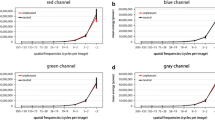Abstract
A framework for accounting for emotional phenomena proposed by Sokolov and Boucsein (2000) employs conceptual dimensions that parallel those of hue, brightness, and saturation in color vision. The approach that employs the concepts of emotional quality, intensity, and saturation has been supported by psychophysical emotional scaling data gathered from a few trained observers. We report cortical evoked potential data obtained during the change between different emotions expressed in schematic faces. Twenty-five subjects (13 male, 12 female) were presented with a positive, a negative, and a neutral computer-generated face with random interstimulus intervals in a within-subjects design, together with four meaningful and four meaningless control stimuli made up from the same elements. Frontal, central, parietal, and temporal ERPs were recorded from each hemisphere. Statistically significant outcomes in the P300 and N200 range support the potential fruitfulness of the proposed color-vision-model-based approach to human emotional space.
Similar content being viewed by others
References
Allison, T., Ginter, H., McCarthy, G., Nobre, A., Puce, A. L. M., & Spencer, D. D. (1994). Face recognition in human extrastriate cortex.Journal of Neurophysiology, 71, 821–825.
Benton, A. L. (1990). Facial recognition.Cortex, 26, 491–499.
Bötzel, K., & Grüsser, O.-J. (1989). Electric brain potentials evoked by pictures of faces and non-faces: a search for „face-specific” EEG potentials.Experimental Brain Research, 77, 349–360.
Borod, J. C. (1992). Interhemispheric and intrahemispheric control of emotion: a focus on unilateral brain damage.Journal of Consulting and Clinical Psychology, 60, 339–348.
Carretie, L., & Iglesias, J. (1995). An ERP study on the specificy of facial expression processing.International Journal of Psychophysiology, 19, 183–192.
Chernorizov, A. M., Zimachev, M. M., & Sokolov, E. N. (1998). Color space of frog. Moscow: Unpublished manuscript.
Damasio, A. R., Tranel, D., & Damasio, H. (1990). Face agnosia and the neural substrates of memory.Annual Review of Neuroscience 13, 89–109.
Davidson, R. J. (1983). Hemispheric specialization for cognition and affect. In A. Gale, & J. Edwards (Eds.):Psychological Correlates of Human Behaviour (pp. 203–216). London: Academic Press.
Diedrich, O., Naumann, E., Maier, S., Becker, G., & Bartussek, D. (1997). A frontal positive slow wave in the ERP associated with emotional slides.Journal of Psychophysiology.11, 71–84.
Ekman, P., & Friesen, W. V. (1976).Pictures of facial affect. Palo Alto: Consulting Psychologists Press.
Etcoff, N. L., & Magee, J. J. (1992). Categorical perception of facial expressions.Cognition, 44, 227–240.
Furedy, J. J., & Heslegrave, R. J. (1985). The relative sensitivities of heart rate and T-wave amplitude to stress: Comments on, and some alternative interpretations of Penzien et al’s results.Biological Psychology, 19, 55–61.
Guthrie, D., & Buchwald, J. S. (1991). Significance testing of difference potentials.Psychophysiology, 28, 240–244.
Hasselmo, M. E., Rolls, E. T., & Baylis, G. C. (1989). The role of expression and identity in the face-selective responses of neurons in the temporal visual cortex of the monkey.Behavioural Brain Research, 32, 203–218.
Izmailov, Ch. A., Korshunova, S. G., & Sokolov, E. N. (2000). Relationship between visual evoked potentials and subjective differences of emotional expression of a schematic face (in Russian).Journal of Higher Nervous Activity (in print).
Izmailov, C. A., & Sokolov, E. N. (1991). Spherical model of color and brightness discrimination.Psychological Science, 2, 249–259.
Jasper, H. H. (1958). The ten-twenty electrode system of the international federation.Electroencephalography and Clinical Neurophysiology, 10, 371–375.
Lang, S. F., Nelson, C. A., & Collins, P. F. (1990). Event-related potentials to emotional and neutral stimuli.Journal of Clinical and Experimental Neuropsychology, 12, 946–958.
Laurian, S., Bader, M., Lanares, J., & Oros, L. (1991). Topography of event-related potentials elicted by visual emotional stimuli.International Journal of Psychophysiology, 10, 231–238.
Naumann, E., Bartussek, D., Diedrich, O., & Laufer, M. E. (1992). Assessing cognitive and affective information processing functions of the brain by means of the late positive complex of the event-related potential.Journal of Psychophysiology, 6, 285–298.
Ojeman, J. G., Ojeman, G. A., & Lettich, E. (1992). Neuronal activity related to faces and matching in human right nondominant temporal cortex.Brain, 115, 1–13.
Kapcsak, S. Z., Comer, J. F., & Rubens, A. B. (1993). Anomia for facial expressions: Neuropsychological mechanisms and anatomical correlates.Brain and Language, 45, 233–252.
Reuter-Lorenz, P. & Davidson, R. J. (1981). Differential contributions of the two cerebral hemispheres to the perception of happy and sad faces.Neuropsychologia, 19, 609–613.
Ritter, W., Simson, R., & Vaughan, H. G., jun. (1983). Event-related potential correlates of two stages of information processing in physical and semantic discrimination tasks.Psychophysiology, 20, 168–79.
Sergent, J., Ohta, S., Mac Donald B., & Zuck, E. (1994). Segregated processing of facial identity and emotion in the human brain: a PET study.Visual cognition, 1, 349–369.
Sokolov, E. N. (1998). Model of cognitive processes. In M. Saburin, F. Craik, & M. Robert (Eds.),Advances in Psychological Science, Vol. 2: Biological and cognitive aspects (pp. 355–379). Hove, East Sussex, UK: Psychology Press.
Sokolov, E. N., & Boucsein, W. (2000). A psychophysiological model of emotion space.Integrative Physiological and Behavioral Science, 35, 81–119.
Sokolov, E. N., & Izmailov, C. A. (1983). The conceptual reflex arc: A model of neural processing as developed for colour vision. In H. G. Geissler (Ed.),Modern Issues in Perception (pp. 192–216). Amsterdam: North Holland. Vanderploeg, R. D. Brown, W. S. & Marsh, J. T. (1987). Judgments of emotion in words and faces: ERP correlates.International Journal of Psychophysiology, 5, 193–205.
Wallbott, H. G., & Ricci-Bitti, P. (1993). Decoders’s processing of emotional facial expression—a top-down or bottom-up mechanism?European Journal of Social Psychology, 23, 427–443.
Author information
Authors and Affiliations
Corresponding author
Rights and permissions
About this article
Cite this article
Boucsein, W., Schaefer, F., Sokolov, E.N. et al. The color-vision approach to emotional space: Cortical evoked potential data. Integr. psych. behav. 36, 137–153 (2001). https://doi.org/10.1007/BF02734047
Issue Date:
DOI: https://doi.org/10.1007/BF02734047




